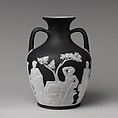Portland vase
Factory Josiah Wedgwood and Sons British
Not on view
Josiah Wedgwood, whose ceramic creations evoked the styles and themes of antiquity so popular in the late eighteenth century, produced a copy of the celebrated Portland Vase in black-and-white jasper-ware. The original, attributed to the Roman gem-cutter Dioskourides, is in the style of works made between 30 and 20 B.C. After its discovery in the late sixteenth century in the tomb of the Emperor Septimius Severus, it became one of the most admired works of antiquity and passed through an illustrious series of collections, among them those of Cardinal Barberini, Sir William Hamilton, and finally, the duchess of Portland, who donated it to the British Museum.
The iconography of the original black-and-white cameo-cut glass vessel remains a mystery, though many interpretations have been offered. A recent theory is that the frieze depicts (as the vessel is turned) Peleus entering to meet Thetis in the presence of her parents and Aphrodite and that the vase was made as a wedding present for the Emperor Augustus's daugher Julia on her marriage to Marcus Claudius Marcellus, her cousin, in 25 B.C.
Wedgwood continued to issue editions of the vase throughout the nineteenth and twentieth centuries.
#2140. Portland Vase
Due to rights restrictions, this image cannot be enlarged, viewed at full screen, or downloaded.
This artwork is meant to be viewed from right to left. Scroll left to view more.




